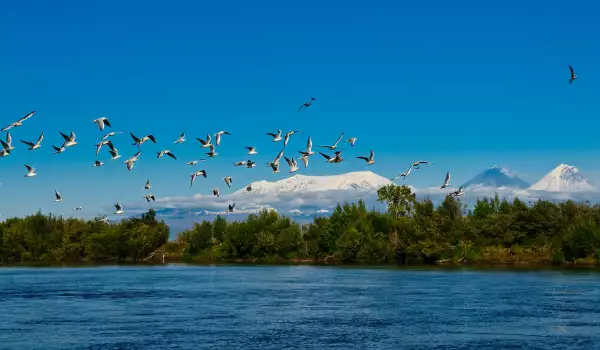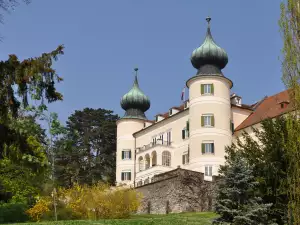Kamtschatka

In the vast Russian Kamtschatka Peninsula is one of the most interesting and beautiful places of natural diversity.
Kamtschatka is located in northeastern Russia. The peninsula sits between two seas - the Sea of Okhotsk and the Bering Sea to the right, and the North Pacific to the left. From end to end, the length of Kamtschatka is about 1200 km and carries a 450 km width, it covers a total area of 472 300 sq. km.

Located in the eastern part of Eurasia, the territory of Russian Kamtschatka is a prototype of the earth - such as it was millions of years ago. Kamtschatka has long been known as an active volcanic area. The peninsula is located on the Pacific Ring of Fire, and this is why the record number of volcanoes that are found in this Russian land.
There are 162 volcanoes in one place, to be seen in Kamtschatka, 28 of which are still active. The highest volcano in Eurasia and the highest point in Kamtschatka is Klyuchevskaya Sopka, at 4750 meters high. Around it are 12 more smaller volcanoes, and Klyuchevskaya Sopka stands out in remarkably correct form. This area is organized in a natural park and is under the auspices of UNESCO since 1996.
Volcanoes in Kamtschatka are known as "stone torches" and are so many that you would not believe it. South to north on the peninsula lie two volcanic ridges - Middle and East. The median ridge is older than the Eastern and extends to some 900 km in length. On this almost 1 km are formed 120 volcanoes and more than 1, 000 slag cones.
Currently operating in this part of Kamtschatka are only the volcanoes Ichinski and Hangar. Ichinski is the highest volcano in the middle ridge, it reaches a height of 3621 meters. Very beautiful with its strange shape and eruptions of blue obsidian, this volcano is attractive to many people, but the routes to it are available only for the most experienced climbers.
Here are some of the cleanest waters on the planet, and the cleanest air on Earth.
Nature here is incredibly rich - the valleys and river beds are filled with fish, particularly salmon, in Kamtschatka there are large populations of bears. Everywhere wondrous areas of virgin forests and tundra can be found. Kamtschatka is a popular place for hunting and the most attractive species here are Kamtschatkan moose and white Kamtschatkan ram.
A newer volcanic activity in Kamtschatka is represented by the eastern ridge. It reaches a length of 850 km and there are about 100 powerful volcanoes, 30 of them active. Six volcanoes, namely Mutnovski, Avachinski, Karimski, Klyuchevskoy, Shiveluch and Bezimenniy and are considered very active. The group called “domestic”volcanoes, which includes Koryak (3456 m) Avachinski (2751 m) and Kozelski (2190 m). Of them, active are Avachinski and Koryak and they are next t othe city of Petropavlovsk. Avachinski has long been attractive to tourists, and ascent takes about 6-8 hours with a mountain guide.
At the foot of the volcano two of the residential suburbs of Petropavlovsk are located. On the slopes of the volcanoes are excellent conditions for skiing and snowboarding, as the snow lasts until mid-July. Not surprisingly, Kamtschatka has often been voted as the "Russian Switzerland". Of course the natural resources in the Northern Territory are quite different, but in many places there are excellent ski resorts.
Petropavlovsk-Kamchatsky is one of the oldest Cities in the Russian Far East and the largest city in Kamtschatka. Here 65% of the population of the peninsula lives. Avacha Bay, is among the largest natural harbors in the world.
About 80 km south of Petropavlovsk is Goreliy volcano. 1829 meters high, it is kind of like the Hawaiian volcanoes - an interesting structure with its 10 craters, some of which are filled with volcanic Lakes. Climbing the volcano is not difficult and is very popular among lovers of alpine ascents.
More nteresting, in Kamtschatka are the volcanoes, Karimski and Bezimenniy Shiveluch, which are also active at this time.
An interesting attraction in Kamtschatka is the Valley of geysers, where there are about 90 geysers. Here the water fountains gush hot life-giving liquids at a height of 40 meters, steam clouds rise about 200 meters. The Valley of geysers is also included in the UNESCO list of World Heritage. In 2007, however, landslides changed the appearance of this area.
Kamtschatka is extremely rich and as- of- yet a still undiscovered natural area. It was discovered by Cossacks about 300 years ago, and during the Second World War was developed as a military area, so at its borders here, are many military bases. Therefore, the Kamtschatka area remained closed to people until 1990. Then you needed special permission to gain access. Kamtschatka is extremely rich in oil.






